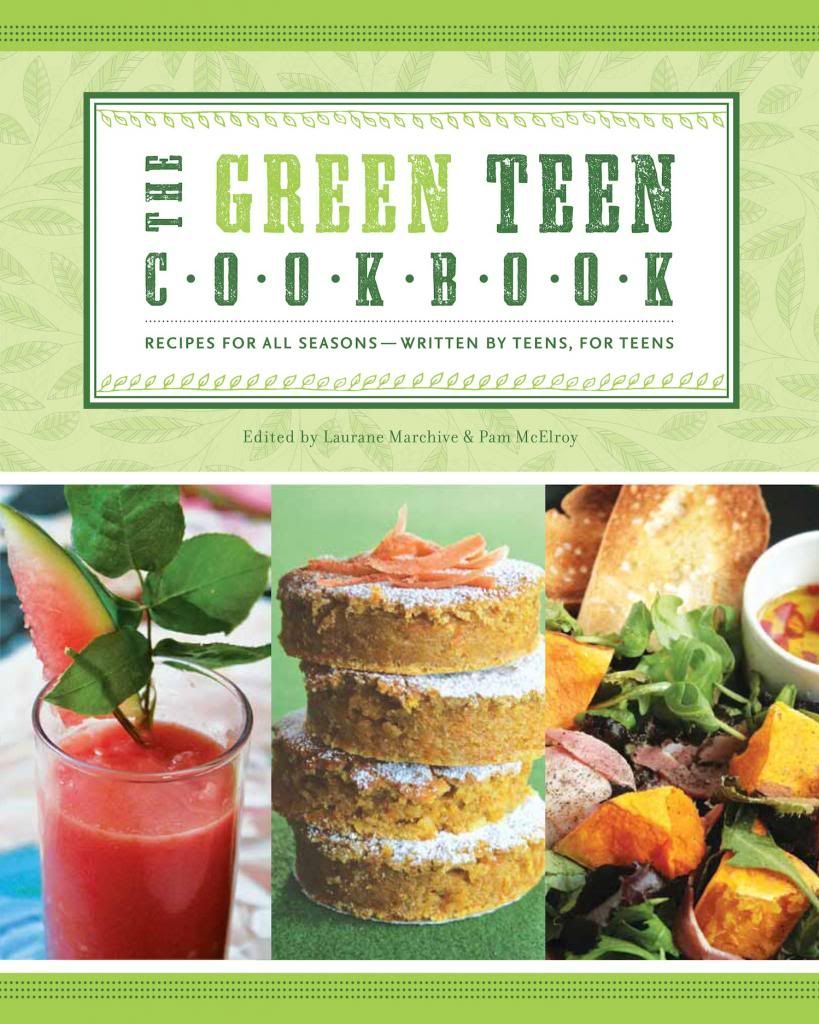 Title: The Green Teen Cookbook
Title: The Green Teen CookbookEditors: Laurane Marchive & Pam McElroy
Publisher: Zest Books
Publication Year: 2014
Read: August 2014
Where It Came From: Paper review copy from publisher
Genre: Cookbook
Rating: 3 Organic Tomatoes
We can’t believe summer is nearly over (right?!), but we thought we’d prolong the sunny days of fun just a little bit longer by joining Zest Books’ Summer Bloggin Blog Tour and reviewing a couple of their books about cooking and crafting. Up today is The Green Teen Cookbook, a tome of cookery full of “recipes for all seasons—written by teens, for teens.” This is a cookbook with a lot of ideas: the primary ones are that teens around the world are experienced cooks with sophisticated tastes, and you, too, can Eat Green. As to what green eating means, there are six essays prefacing the recipes that give you perspectives like Eat Seasonal Vegetables, or Buy Organic Produce. This is basically stuff we agree with. But (and of course there was going to be a but with that setup), our overall impression is that there are too many ideas to fully coalesce into the sort of cookbook we’re going to grab off our shelves every time we get hungry.
As far as we can tell, most of the greenness of this book comes from the first chapter, “A Rough Guide to Healthy, Environmentally Conscious Cooking.” It’s comprised of the abovementioned six essays covering such topics as eating healthfully and seasonally, what “organic” is all about, vegetarianism, the locavore movement, and fairtrade. They are written with varying degrees of skill and helpfulness, but we enjoyed “How to Eat Seasonally” and “What is Fairtrade?” and thought they contained a lot of interesting information. On the other hand, both the vegetarian and the meat eater were a little nonplussed by the tone and lack of focus in “Vegetarianism.”
What disappointed us a little was that the green eating ideas from these essays didn’t carry over into the rest of the cookbook as much as we had hoped. Each recipe has icons indicating what season it is appropriate to prepare the dish in, and the end of each chapter includes seasonal variations on a single classic dish such as pie, sandwiches, or lasagna, but it might have been nice to have some sort of overall seasonal arrangement of the recipes, and to situate them within the other realms of green eating in some way.
We found the cookbook more satisfying when focusing on the “for teens, by teens” aspect of it. It’s organized into meal-themed chapters, with such categories as breakfast and brunch; soups, salads, and sandwiches; snacks and sides; main courses; and desserts. Each recipe has a photo of the teen who submitted it, with a quote from them about the recipe serving as the header text. The recipes range from the simple, like hummus and guacamole, to the more complex or ones that utilize more unusual ingredients (for example, the Oaxacan squash blossom quesadilla with chipotle crema). Teens from all around the world contributed to the book and as a result it has a very international vibe, with recipes for curry, sushi, and sancocho (a soup from the Dominican Republic), among others. It also covers the basics, though—steak, mashed potatoes, oatmeal cookies…things like that. Though the photos of the dishes aren’t at the level of food art you might see in some cookbooks out there, they showcase the food well and give you a good idea of how your cooking should turn out. (But where is that delicious-looking watermelon drink from the cover?? We couldn’t find it anywhere in the book. :c)
One of our favorite chapters was the one dedicated to recipes for making your own kitchen staples (these recipes were written by the editors, not the teen contributors). It’s cool to see how simple it is to make things like vinaigrette, tomato sauce, pesto, mayonnaise, peanut butter, and stock from scratch, so you can enjoy them without preservatives and other additives, and at a lower price than you would get purchasing them ready-made at the grocery store.
Other nice features of the book include a resources section at the back with a list of some of the best farmer’s markets in the U.S., info about locating one near you, directions on where to find info about Community Supported Agriculture, and a list of good cooking-related websites and blogs. The helpful tips sprinkled throughout the book also help the reader boost their cooking skills up to the next level.
Overall, we would emphasize The Green Teen Cookbook’s success as a crowd-sourced teen cookbook more than it being super-green. And while it’s by no means a master class in green eating and cooking, it covers the basics and would serve as a good primer for teens interested in the topic and inspire them to further research. The book may not hold as much interest for those well-versed in the ways of green or for experienced chefs and home cooks, but we think it would make a great gift for kids and teens interested in getting started cooking, or for college students cooking on their own for the first time and looking to make environmentally-conscious decisions in the process.
(Note: We had hoped to include our interview with the book’s editor in this post, but we’ll update it with that as soon we get her responses!)
*As ever, much as we are grateful for the copy, our review is uninfluenced by its source.







No comments:
Post a Comment